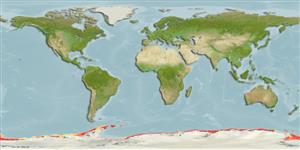Chaenodraco wilsoni Regan, 1914
Spiny icefish
Waarneming toevoegen in Fish Watcher
| Native range | All suitable habitat | Point map | Year 2050 |

|
| This map was computer-generated and has not yet been reviewed. |
| Chaenodraco wilsoni AquaMaps Data sources: GBIF OBIS |
Uploaden van uw Foto's en video's
Pictures | Google afbeeldingChaenodraco wilsoni
Picture by Busse, K.
Pictures | Google afbeeldingChaenodraco wilsoni
Picture by Busse, K.
Common names from other countries
Classificatie / Names Lokale namen | Synoniemen | Catalog of Fishes(Genus, Soort(en)) | ITIS | CoL | WoRMS | Cloffa
> Perciformes/Notothenioidei (Icefishes) > Channichthyidae (Crocodile icefishes)
Etymology: Chaenodraco: Greek, chaeno = to yawn + Greek, drako = dragon (Ref. 45335).
Eponymy: Dr Edward Adrian Wilson (1872–1912) was an English physician, polar explorer, painter and natural historian. [...] (Ref. 128868), visit book page.
More on author: Regan.
Etymology: Chaenodraco: Greek, chaeno = to yawn + Greek, drako = dragon (Ref. 45335).
Eponymy: Dr Edward Adrian Wilson (1872–1912) was an English physician, polar explorer, painter and natural historian. [...] (Ref. 128868), visit book page.
More on author: Regan.
Environment: milieu / climate zone / depth range / distribution range Ecologie
marien benthopelagisch; diepte 200 - 800 m (Ref. 5200). Polar; 60°S - 78°S, 180°W - 180°E (Ref. 5200)
Verspreiding Landen | FAO regio's | Ecosystemen | Voorkomen | Point map | Introducties | Faunafri
Southern Ocean: Circum-Antarctic on Antarctic continental shelf. Northernmost records from vicinity of South Orkney Islands and Antarctic Peninsula.
Lengte bij maturiteit / Grootte / Gewicht / Leeftijd
Maturity: Lm ?, range 23 - ? cm
Max length : 43.0 cm TL mannelijk / geslacht onbekend; (Ref. 5200); common length : 30.0 cm TL mannelijk / geslacht onbekend; (Ref. 2805)
Max length : 43.0 cm TL mannelijk / geslacht onbekend; (Ref. 5200); common length : 30.0 cm TL mannelijk / geslacht onbekend; (Ref. 2805)
Korte beschrijving Determinatiesleutels | Morfologie | Morfometrie
Dorsale stekels (totaal) : 5 - 8; Dorsale zachte stralen (totaal) : 38 - 42; Anale stekels: 0; Anale zachte stralen: 32 - 36. Supraorbital ridge not crenulated. Middle lateral line restricted to caudal peduncle; lower lateral line originating from in front of anal-fin origin to above sixth anal ray. Maxilla extending to below anterior third of eye. Opercular bones with 2 upper and 3 lower spines. Preopercular-mandibular canal not joined to temporal canal. Pelvic fins extending beyond anal-fin origin. In life, pale grey, whitish ventrally. Differentiated by the dorsoventrally oval shape; the prominent distally rounded rostrum, pseudo-rostrum and pseudo-antirostrum; the clearly defined excisura ostii and pseudo-excisura ostii; the acutely constricted collum; and the well developed colliculli.
Ontogeny: The excisura ostii and the pseudo-excisura ostii become deeper and the crista inferior becomes less distinct with an increase in the fish size.
Common in shallower waters of the continental shelf, especially on banks less than 250 m deep in areas where local upwelling increase food supply (Ref. 6390). Postlarvae and pelagic juveniles are also found in the upper 100 m (Ref. 5200). Food consists of fishes and krill. Spawn in winter (Ref. 6390). Larval pelagic phase is long (Ref. 28915). Prey to penguins and seals (Ref. 6390). Utilized as a food fish (Ref. 5200).
Levenscyclus en paargedrag Maturiteit | Voortplanting | Paaien | Eieren | Fecunditeit | Larven
Hoofdreferentie
Upload your references | Referenties | Coördinator | Medewerkers
Iwami, T. and K.-H. Kock, 1990. Channichthyidae. p. 381-389. In O. Gon and P.C. Heemstra (eds.) Fishes of the Southern Ocean. J.L.B. Smith Institute of Ichthyology, Grahamstown, South Africa. 462 p. (Ref. 5200)
Gevaar voor de mens
Harmless
Gebruik door de mens
Visserij: van minder commercieel belang
FAO(visserij: productie; publication : search) | FishSource | Sea Around Us
Meer informatie
Population dynamics
Groeiparameters
Max. ages / sizes
Length-weight rel.
Length-length rel.
Lengtefrequenties
Massaconversie
Rekrutering
Abundantie
Groeiparameters
Max. ages / sizes
Length-weight rel.
Length-length rel.
Lengtefrequenties
Massaconversie
Rekrutering
Abundantie
Life cycle
Voortplanting
Maturiteit
Fecunditeit
Paaien
Spawning aggregations
Eieren
Ontwikkeling van de eieren
Larven
Larvale populatiedynamiek
Voortplanting
Maturiteit
Fecunditeit
Paaien
Spawning aggregations
Eieren
Ontwikkeling van de eieren
Larven
Larvale populatiedynamiek
Anatomy
Kieuwoppervlak
Brain
Otolith
Kieuwoppervlak
Brain
Otolith
Physiology
Body composition
Nutrients
Zuurstofverbruik
Zwemtype
Zwemsnelheid
Visual pigments
Fish sound
Diseases & Parasites
Toxicity (LC50s)
Body composition
Nutrients
Zuurstofverbruik
Zwemtype
Zwemsnelheid
Visual pigments
Fish sound
Diseases & Parasites
Toxicity (LC50s)
Human related
Aquaculture systems
Aquacultuurprofielen
Kweeklijnen
Ciguatera cases
Stamps, coins, misc.
Aquaculture systems
Aquacultuurprofielen
Kweeklijnen
Ciguatera cases
Stamps, coins, misc.
Tools
E-boek | Veldgids | Determinatiesleutels | Lengtefrequentie Tool | Levenscyclus tool | Verspreidingskaart | Classification Tree
| Catch-MSY |
Speciale rapporten
Bekijk gegevens voor het houden in een aquarium | Bekijk Fact Sheets voor de soort | Bekijk Aquacultuur Fact Sheets
Download XML
Internetbronnen
Aquatic Commons | BHL | Cloffa | Websites from users | Bekijk FishWatcher | CISTI | Catalog of Fishes(Genus, Soort(en)) | DiscoverLife | ECOTOX | Faunafri | Fishtrace | GenBank(genoom, nucleotide) | GloBI | GOBASE | | Google Books | Google Scholar | Google | IGFA World Record | MitoFish | Otolith Atlas of Taiwan Fishes | PubMed | Reef Life Survey | Scirus | SeaLifeBase | Tree of Life | Wikipedia(ga naar, zoek) | World Records Freshwater Fishing | Zoobank | Zoological Record
Estimates based on models
Preferred temperature (Ref. 115969): -1.8 - 1.4, mean -0.8 (based on 825 cells).
Fylogenetische diversiteitsindex (Ref. 82804): PD50 = 1.0000 [Uniqueness, from 0.5 = low to 2.0 = high].
Bayesian length-weight: a=0.00098 (0.00057 - 0.00167), b=3.53 (3.38 - 3.68), in cm Total Length, based on LWR estimates for this species & (Sub)family-body (Ref. 93245).
Trofisch niveau (Ref. 69278): 3.2 ±0.2 se; based on diet studies.
Weerstandsvermogen (Ref. 120179): Gemiddeld, minimale populatieverdubbelingstijd 1,4-4,4 jaar (Fec = 393-862).
Fishing Vulnerability (Ref. 59153): Low to moderate vulnerability (33 of 100).
Climate Vulnerability (Ref. 125649): High vulnerability (64 of 100).




